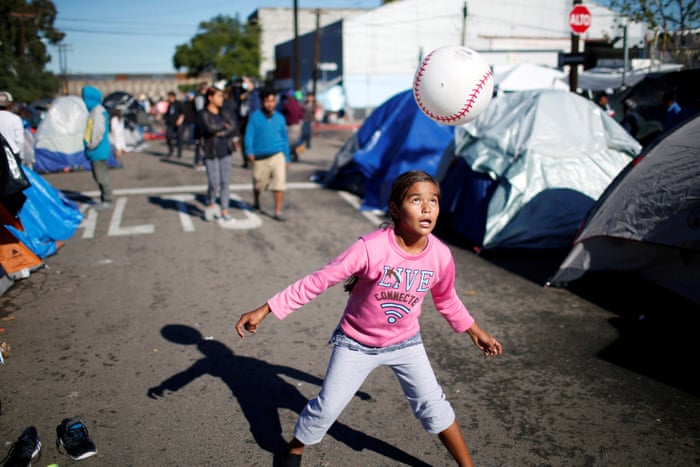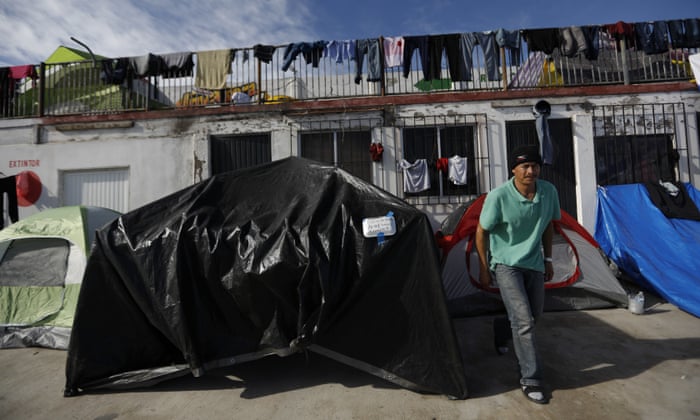'I don't want to go back': what's next for the Central American migrant caravan?
 A migrant, part of a caravan of thousands from Central America trying to reach the US, plays with a ball as she shelters on the street in Tijuana. Photograph: Mohammed Salem/Reuters
A migrant, part of a caravan of thousands from Central America trying to reach the US, plays with a ball as she shelters on the street in Tijuana. Photograph: Mohammed Salem/Reuters Amanda Holpuchin Tijuana@holpuch-
Amanda Holpuchin Tijuana@holpuch-While some have returned home, many members seek a better life as they seek local jobs and await word from US authorities
Inside the Tijuana migrant shelter that has become a home for thousands of Central American migrants, 55-year-old Carlos Gómez approached some strangers asking if they knew where he could find a job.
Gómez was one of thousands who fled Honduras with the migrant caravan that arrived in Tijuana one month ago. He would still like to seek asylum in the US, but with thousands of people ahead of him in the line to submit an application, he would be content to stay in Mexico, he says.
“I need the work, I don’t want to go back to Honduras,” said Gómez in El Barretal’s enormous open courtyard, where the few spaces not occupied by tents are filled with lines of people waiting to receive donated sandwiches and piles of warm winter clothes.
Despite the open hostility of Donald Trump, most members of the recent migrant caravans headed north in the belief – fed by rumors and often bolstered by their deep Christian faith – that they would quickly be granted asylum.
Now, after a cold welcome in Tijuana – where they have faced xenophobic reactions from local people and been teargassed by US border officials – some migrants have chosen to head home.
But most have remained in Tijuana, intent on building a life more tenable than one defined by the violence and unrest back home.
 A man emerges from a tent advertising phone recharges at the former concert venue Barretal in Tijuana. Photograph: Rebecca Blackwell/AP
A man emerges from a tent advertising phone recharges at the former concert venue Barretal in Tijuana. Photograph: Rebecca Blackwell/APGómez made the 2,000-mile journey to Mexico alone, after his family was forced off their property and targeted by gangs. “I couldn’t live in that country anymore,” he said.
He accepted the Mexican government’s offer to provide work permits to the migrants but said he had been waiting two weeks for his application to be processed.
Until that happens, Gómez – along with thousands of others – remains at Barretal, a concert hall turned refugee camp. The migrants were transferred here last week after a previous facility – a sports center – was flooded during torrential rains and health workers warned of dangerous, unsanitary conditions.
In Barretal’s multi-story indoor facility, children’s chatter bounces off the walls endlessly as kids stampede down staircases and through corridors, turning any structure, including the music venue bar, into a playground.
Adults hold hushed conversations, rustle through backpacks and suitcases to find a certain shirt or hat and empty plastic bags of donated bathroom supplies to examine on their blankets.
Denis, 31, said the only quiet in the camp came late at night.
He traveled alone from Guatemala, planning to seek asylum in the US, where his mother became a citizen several years ago. Denis said she applied for him to join her more than two years ago, but he does not know what has been happening with the application and is skeptical her attorney will actually help him. He asked that his name not be used so his chances of getting to the US wouldn’t be jeopardized.
“I could be close to getting papers, but if I cross I could be close to ruining it,” Denis said. “There’s a lot uncertainty.”
According to Denis, El Barretal is a better place to figure out his next move than the unsanitary conditions at the sports stadium.
But in exchange for improved sanitation, space and shelter, migrants were forced to accept being much farther from the border. The location is about 11 miles from the San Ysidro port of entry, where asylum seekers manage an unofficial, handwritten list to determine who is next in the line to apply for asylum in the US.
Denis, 31, said the only quiet in the camp came late at night.
He traveled alone from Guatemala, planning to seek asylum in the US, where his mother became a citizen several years ago. Denis said she applied for him to join her more than two years ago, but he does not know what has been happening with the application and is skeptical her attorney will actually help him. He asked that his name not be used so his chances of getting to the US wouldn’t be jeopardized.
“I could be close to getting papers, but if I cross I could be close to ruining it,” Denis said. “There’s a lot uncertainty.”
According to Denis, El Barretal is a better place to figure out his next move than the unsanitary conditions at the sports stadium.
But in exchange for improved sanitation, space and shelter, migrants were forced to accept being much farther from the border. The location is about 11 miles from the San Ysidro port of entry, where asylum seekers manage an unofficial, handwritten list to determine who is next in the line to apply for asylum in the US.
